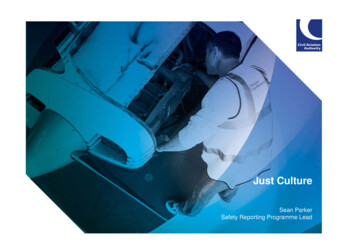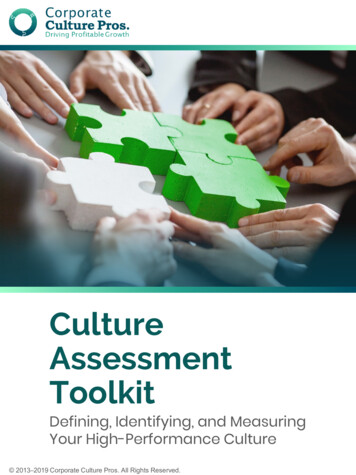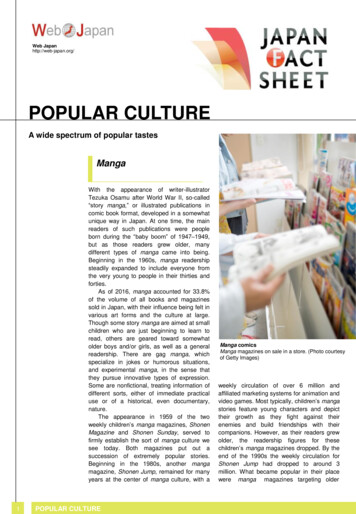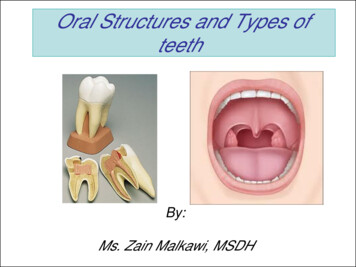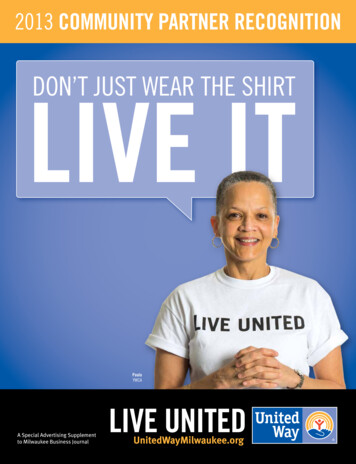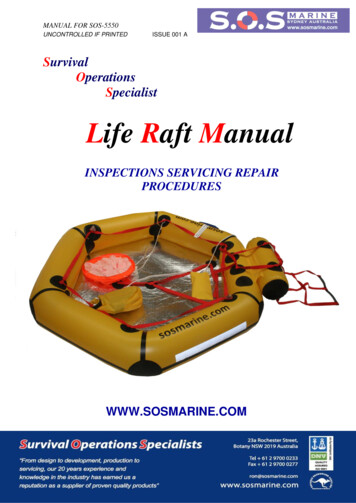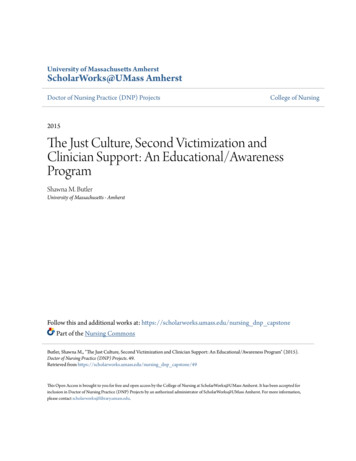
Transcription
University of Massachusetts AmherstScholarWorks@UMass AmherstDoctor of Nursing Practice (DNP) ProjectsCollege of Nursing2015The Just Culture, Second Victimization andClinician Support: An Educational/AwarenessProgramShawna M. ButlerUniversity of Massachusetts - AmherstFollow this and additional works at: https://scholarworks.umass.edu/nursing dnp capstonePart of the Nursing CommonsButler, Shawna M., "The Just Culture, Second Victimization and Clinician Support: An Educational/Awareness Program" (2015).Doctor of Nursing Practice (DNP) Projects. 49.Retrieved from https://scholarworks.umass.edu/nursing dnp capstone/49This Open Access is brought to you for free and open access by the College of Nursing at ScholarWorks@UMass Amherst. It has been accepted forinclusion in Doctor of Nursing Practice (DNP) Projects by an authorized administrator of ScholarWorks@UMass Amherst. For more information,please contact scholarworks@library.umass.edu.
Running head: PROVIDER SUPPORT AWARENESS PROGRAMThe Just Culture, Second Victimization & Clinician Support:An Educational/Awareness ProgramShawna M. ButlerUniversity of MassachusettsSubmitted to the Graduate School of the University of Massachusetts Amherst in partialfulfillment of the requirements for the degree of DOCTOR OF NURSING PRACTICEMay, 2015College of NursingSchool of Nursing Committee Chair: Raeann LeBlanc, DNP, ANP-BC, GNP-BC, CHPN-BCSchool of Nursing Committee Co-Chair: Joan Roche, RN, PhDExternal Committee Member: Laura Rossi, RN, PhD1
PROVIDER SUPPORT AWARENESS PROGRAMAbstractDue to the continued numbers of medical errors and unexpected patient outcomes, the studentproject manager identified the collateral damage that health care providers involved in the patientcare events experienced while acting as a risk manager at one medical center. This concept isreferred to as "second victimization". The patient and/or family are the primary victims of errorsand unexpected outcomes, but the close second is that of the clinician caring for the patient. As aresult of this, the concern for the needs of these second victims was considered. A review of theliterature was conducted. The review supported the concept of organizational support systemsthat provide the second victims with emotional and professional support during these challengingtimes. Medically Induced Trauma Support Services (MITSS) created an evidence based toolkitfor initiating a clinician support program at any facility. The literature and the MITSS toolkitwere utilized to create a plan, budget, evaluation and timeframe for a pilot program educatingand making clinicians aware of the need for a clinician support program at MassachusettsGeneral Hospital in Boston. Twenty potential participants were identified by a nominationprocess and invited to participate. Eleven completed the program in its entirety (pre-survey,educational program, and post-survey). Each member (100%) reported their knowledgeincreasing on second victimization and just culture as a result of the program. A significantnumber reported their interest in being part of a future peer support program. It is the hope of thestudent project manager that this pilot serves as a foundation for a future clinician supportprogram.Keywords: second victims, provider support programs2
PROVIDER SUPPORT AWARENESS PROGRAMTable of ContentsAbstract 2Problem Statement, Background and Significance .4Review of Literature Search Methods .5Literature Review Findings .8Theoretical Framework .16Goals and Objectives .18Project Setting Description 18Sample 19Design & Methods .24Method of Evaluation 25Plan, Budget, & Timeframe .25-29Results . .29Discussion .32Summary 35References 38-44Appendix A-I .45-533
PROVIDER SUPPORT AWARENESS PROGRAMProvider Support Awareness ProgramProblem StatementPatients experience medical errors at an alarming rate. This is despite the 1999 landmarkreport by the Institute of Medicine (IOM) stating that approximately 98,000 patients die eachyear due to medical error (IOM, 1999). Over 10 years later, preventable medical harm stillaccounts for more than 100,000 deaths each year despite countless programs and extensivefunding to improve patient safety (Safe Patient Project, 2009). Medical errors are traumatic forthose closest to the event. Patients and/or their families are the primary victims who suffer theconsequences of these events for obvious reasons. However, the involved providers mayexperience trauma as well and this is much less known and much less discussed. Thisphenomenon is known as "second victimization". Clancy (2012) reports that clinicians can be sowounded by the event themselves that it can manifest as anxiety, depression and shame.Background and SignificanceTo promote a culture of safety, punitive measures should be avoided with hardworkingprofessionals that show promising potential for the future and did not show blatant disregard forpatient safety, but were involved in an unintentional human error (Steefel, 2008). Steefel (2008)supports counseling for inadvertent human error through a slip or lapse, and to punish only whenthere was a conscious disregard of unreasonable risk. A "complete understanding of thisphenomenon is essential to design and test supportive interventions that achieve a healthyrecovery" (Scott et al., 2009, p. 325).The University of Missouri reported that 1 in 7 staff members involved in a patient safetyerror within the previous year experienced personal problems related to the error (Scott, 2011).4
PROVIDER SUPPORT AWARENESS PROGRAMThese caregivers report experiencing feelings of failing the patient, questioning their ownclinical skills and abilities, as well as doubting their career choice (Scott et al., 2009). Scott et al.(2009) suggest that these providers benefit from support. This support can be in the form of aninstitutionalized provider support program also referred to as a "care for the caregiver" program.Medically Induced Trauma Support Services (MITSS) is a non-profit organization startedby a patient and the physician who were involved in an error in the patient's medical care. Theirmission is to support patients, families and providers. MITSS recommends that althoughprograms may take many forms, "clinician and staff support should be part of each institution'soperational response to adverse events" (Carr, 2009, p. 2). Denham (2007) purports that secondvictims are owed 5 rights (just treatment, respect, compassion, support and transparency). (SeeAppendix A for further detail). Scott et al. (2009) report the need for the facility's response planto establish not only an institutional support network that will rescue those second victims whoneed peer support, but also those who need more than peer/colleague support.The purpose of this project is to lay the foundation for implementation of an institutionalsupport plan that will provide emotional first aid and professional guidance and evaluate theimpact on provider retention and satisfaction in a hospital/health system setting. The first steps ofthis process include increasing institutional awareness and identifying potential future staff whocan be supporters via this pilot program. The pilot included implementing an educational andawareness pilot to a group of staff members that could also be future supporters. To followincludes the detail surrounding the research utilized to complete this project.5
PROVIDER SUPPORT AWARENESS PROGRAMReview of Literature Search MethodsThe following online databases were used to search for the literature utilized in this review:(a) Cumulative Index to Nursing and Allied Health Literature (CINAHL), (b) CINAHLComplete, (c) PubMed, (d) PubMed Central, and (e) Google Scholar. The key words/MesHterms searched were: second victims of adverse events, providers as second victims in healthcare adverse events, provider support programs for second victims, peer support programs forsecond victims, clinician support programs and health care adverse event second victims. Seemore details noted below in both general and specific results.General ResultsA total of 53 articles were reviewed for quality, strength of evidence, applicability andbeing current. Seventeen were used for this literature review and matrix (see Appendix B). Theremainder was not used because they were duplicates of studies already included, lacked strengthof evidence or lacked applicability. Studies older than 8 years were excluded with the goal ofmaintaining the most recent studies on this subject. It was necessary in some circumstances toadd the word/s "health care/healthcare" in some searches because the concept of the secondvictim applies beyond health care adverse events (i.e. the second victimization of rape victims)as was noted above in the key terms. Exclusion criteria were limited because the results yieldedwere less by comparison to more well established topics. The goal was to gather all potentialsources to see where research may have been done or where it may have been lacking. If thesearch resulted in an unrelated topic, such as the second victimization of rape victims notedabove, then it was eliminated. If the article focused more on the legal aspects of a medicaladverse event as opposed to provider impact, this was excluded. If the article did not include6
PROVIDER SUPPORT AWARENESS PROGRAMresearch, did not include significant expert opinion or was more of an editorial article, it wasexcluded for literature review purposes, but had potential for inclusion in the discussion section.High quality research articles were sought out for the literature review. These includedsystematic reviews and original research when they were available. Both qualitative andquantitative research articles were searched for and included. Studies published in English fromboth inside and outside the United States were included. Expert opinion articles, literaturereviews, a doctoral dissertation, case studies and conference proceedings were also included asthis is becoming a more common topic among the experts and at professional conferences.Specific ResultsThe search of CINAHL and CINAHL Complete yielded 4 results total (the same 4 foreach one). All of them were used in this review. All 4 of the abstracts were reviewed prior toinclusion. The PubMed search results included 17 articles. All 17 articles' abstracts werereviewed. Five of the 17 were included in this analysis. The others were excluded due to lack ofapplicability: 1) more related to a legal discussion, 2) a focus on ethical duties owed to thepatient, or 3) on how to prevent the medical error in the future. PubMed Central yielded a total of99 articles. Only 1 of the abstracts was reviewed and included in the analysis as the others wereobviously not applicable due to the title of the article. These papers were unrelated to this subjectmatter. They were focused on post traumatic stress unrelated to medical events, substance abuseor other medical error issues unrelated to this subject matter. Google Scholar included totalresults of 261,000. Only the first 31 results were even remotely related to the topic at hand madeevident by title. All 31 abstracts were reviewed to evaluate if they related to the subject matter.Seven of the 31 were relevant to the topic and were used for purposes of this literature review.7
PROVIDER SUPPORT AWARENESS PROGRAMThe other 24 were excluded because they were either over 8 years old, were more focused on thecause of medical error or how to prevent it or were about post traumatic stress disorder in anunrelated cause.The total number of studies synthesized for the literature review was 17. Other articleswere included for discussion purposes only throughout the paper. Collected data on the 17studies are included in a matrix table for easier review. See Appendix B for the literature reviewmatrix. The John Hopkins Research and Non-Research Evidence Based Practice Appraisal(JHNEBP) were utilized for evaluating the evidence.Literature Review FindingsThe articles included vary from original research to systematic reviews to expert opinionsand were organized by thematic analysis. The three primary areas of focus of the research arearranged according to 1) identifying the effects that adverse medical events have on providers, 2)the need for institutional emotional support programs and 3) the varied approaches to support(i.e. peer support, professional support) and discipline specific studies (i.e. nurses only). Somestudies may have included information on more than 1 of the above areas. As a result, a decisionwas made to include them in 1 area as opposed to the other based on whether their discussionand findings focused more on the effects of being a second victim (#1) or how to supportclinicians or how to implement a program (#2). See Appendix B for an evidence table with detailon each study included in the literature review portion of this proposal.Effects of Adverse Medical Events on ProvidersSix of the 17 studies had a primary focus of reviewing the actual effects that thesemedical events have on providers. They relayed stories of personal problems, psychological8
PROVIDER SUPPORT AWARENESS PROGRAMproblems and a lack of institutional support. One study even noted that clinicians in othercountries experience similar emotions (Seys et al., 2013). They further note that that secondvictims are owed rights, are entitled to a standardized process post-event dependent oncircumstances, and that each clinician will experience 6 predictable stages post-event.A study at the University of Missouri found that 1 in 7 staff members involved in apatient safety error within the previous year experienced personal problems related to the error(Scott, 2011). These "personal problems" included things like anxiety and depression. They alsoreported that 68% reported not receiving any support whatsoever (Scott, 2011).Denham (2007) completed cross-sectional interviews of national patient safety expertsregarding second victimization. Denham (2007) purports that second victims are due 5 rights(just treatment, respect, compassion, support and transparency). (See Appendix A for furtherdetail as noted above). The common theme was that effective support programs need to be put inplace in the same manner that programs are for patients as part of the 5 rights. The respondentsare nationally recognized experts who have experience interacting with second victims as wellconducting their own research on the issue.As a result of the IOM request to the National Council of State Boards of Nursing todevelop and design standardized processes to better distinguish human error from reckless andintentional misconduct, a group of experts collaborated to determine how to manage nurses whoare involved in adverse medical events (Steefel, 2008). Steefel (2008) supports consoling forinadvertent human error through a slip or lapse, for example, and to punish only when there wasa conscious disregard of unreasonable risk.9
PROVIDER SUPPORT AWARENESS PROGRAMSeys et al. (2013) completed a systematic review of the literature surrounding secondvictims and found that this phenomenon has an impact on not only clinicians and colleagues, butalso subsequent patients. It was based on 32 research articles and 9 non-research articles (Seys etal., 2013). They further supported the findings of the other previously mentioned articles that it iscritical to have programs in place that support not just the patient and/or family, but also theprovider (Seys et al., 2013). The review reports themes of sleeplessness, remorse, copingstrategies, just to name a few issues that the providers experienced and that are mentioned in thearticles synthesized (Seys et al., 2013). Sixty percent of physicians who reported an error alsoscreened positively for depression (Seys et al., 2013). Seys et al., (2013) report this phenomenonalso occurs in Norway, Scotland, England, Germany, and Israel.Sirriyeh, Lawton, Gardner and Armitage (2010) also conducted a systematic reviewregarding coping with medical errors. Twenty-four studies were included in this review."Psychological repercussions may include negative states such as shame, self doubt, anxiety andguilt" (Sirriyeh et al., 2010, p. 1). This review was based on fewer articles than the Seys et al.systematic review, but still has significance. Due to the fact that this review culminated in afinding that second victimization is destructive and warrants supportive measures reinforces thisand other studies with similar findings. The authors do however acknowledge the need forfurther literature around coping and support strategies (Sirriyeh, et al., 2010).Scott et al. (2009) conducted semi-structured interviews of 31 second victims. Thefindings of this study purported that the post-event trajectory is largely predictable and typicallyprogresses through six stages (chaos, reflections, integrity restoration, enduring inquisitions,obtaining emotional support, and moving on) and that institutional support systems could bedeveloped to screen at-risk providers and support them through the stages (Scott et al., 2009).10
PROVIDER SUPPORT AWARENESS PROGRAMThis is a small sample size (n 31) and is therefore less generalizable and less reliable, but itdoes support the findings of other research on the same issue and it does measure what it set tomeasure (needs). It is applicable to other settings since it supports similar findings with regard topost event trajectory and need for institutional support.It is evident that clinician self-reports of feelings of shame, doubt, depression and othernegative emotional consequences are genuine and a real concern. Expecting clinicians to beinfallible and emotionally unattached is unrealistic and not healthy for them as individuals andnot healthy for the institution as a whole. One study noted above reported that this has an effecton the subsequent patients cared for (Seys et al., 2013). Ultimately, these natural emotions mustbe acknowledged and addressed as to promote optimal well-being and morale of the clinician.The Need for Implementing Institutional Support ProgramsSix of the 17 articles had the main focus as the need for institutional support programs.The general recommendation was that it was irresponsible on the part of the institution to allowthese affected providers to continue practicing without acknowledgement, the ability to processwhat occurred, and without colleague and/or professional support. It is not only good practice forthe care of the individual provider, but also for the future patients being cared for by thesesecond victims. Feelings of inadequacy and lack of appropriate supports may lead the promisingand potentially successful clinician to leave the profession meaning that patients do not receivethe benefit of that provider’s care (Carr, 2009). It may also leave them vulnerable to makesubsequent errors that could hurt patients (Carr, 2009). As a result of the overall concern that thismay have on the general patient population, one might consider whether supporting secondvictims (along with primary patient victims) as a vital public health matter.11
PROVIDER SUPPORT AWARENESS PROGRAMMedically Induced Trauma Support Services (MITSS) is a non-profit organization startedby a patient and a physician. van Pelt's article about this process is discussed here. The foundingphysician was involved in an error in a patient's (founding member) medical care. The MITSSmission is to support pat
inclusion in Doctor of Nursing Practice (DNP) Projects by an authorized administrator of ScholarWorks@UMass Amherst. For more information, please contactscholarworks@library.umass.edu. Butler, Shawna M., "The Just Culture, Second Victimization and Clinician Support: An Educational/Awareness Program" (2015). Doct
